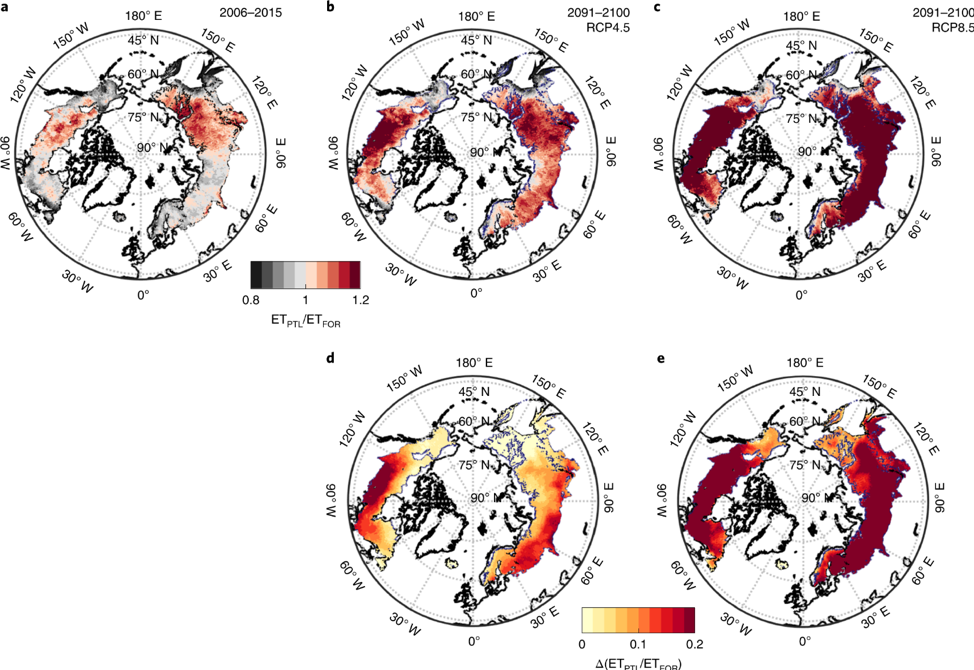 Contact
Contact
 Richard Petrone, Department of Geography and Environmental Management
Richard Petrone, Department of Geography and Environmental Management
Introduction
The boreal biome covers about one-eighth of the global terrestrial land surface area and is comprised of forest (80 per cent), peatland (15 per cent) and lake (five per cent) ecosystems. The total organic carbon stock of the boreal exceeds the stock currently in the atmosphere, with the largest portion found in peatlands. Peatland carbon stocks are impacted by global carbon-climate feedbacks that are sensitive to changes in water availability, which, in turn, is partly controlled by atmospheric water losses through evapotranspiration (ET). Accurate projections of future ET in the boreal region are therefore crucial for quantifying carbon-climate feedbacks in a warming climate.
Most Earth System Models (ESM) currently simulate the boreal region as an upland forest ecosystem while not specifically accounting for peatlands. ET responses to a changing climate in the boreal biome therefore remain poorly understood, hindering our ability to accurately project ET and hence soil moisture trends and carbon-climate feedbacks. In this study, we quantified relationships between ET and the atmospheric vapour pressure deficit (VPD), covering a wide range of the boreal ecosystem to evaluate how ET responds to a warmer climate with increasing atmospheric water demand.
Methodology
Potential ET is driven by available energy and atmospheric VPD, which is a measure of the atmospheric demand for water vapour. Relationships between ET and VPD were quantified using multi-year eddy covariance measurements from 60 forest and 35 peatland sites across the boreal biome (Figure 1). Sites were characterized by a dryness index such that the VPD limitation of ET was expected to dominate soil moisture limitation.

Figure 1: Flux tower locations and spatial pattern of dryness index in the boreal biome. The locations (circles) of peatland (a) and forest (b) eddy covariance flux towers. The colour scheme reflects the mean dryness index during 1981–2010. The probability distribution of the dryness index (c) is shown for the entire boreal biome and for the flux tower sites (n = 95).
To quantify differences in ecosystem controls on ET, we derived surface conductance values under optimal site-specific water supply and aerodynamic conductance values from the eddy covariance measurements. ET and conductance responses to VPD were analysed using boundary line analysis. The Penman–Monteith equation was used to model the peatland ET-VPD response to assess whether aerodynamic or surface conductance was driving the observed difference in ET response.
Outcomes
The study found that, with an increase in VPD, ET increased more in boreal peatlands than in forests, resulting in peatland ET exceeding forest ET by about 30 per cent under a high VPD. This was mainly driven by the higher surface conductance of peatlands. We found that peatland ET exceeds forest ET across the boreal biome by an average of five per cent under current climatic conditions. However, under moderate and most severe climate warming scenarios, this is expected to increase to 13 per cent and 28 per cent, respectively.
In analyzing the instantaneous responses of peatland and forest ET to VPD, we found that the peatland evaporative fraction became increasingly larger than the forest fraction and reached maximum differences of about 60 per cent for high VPD, indicating clear differences in energy partitioning between boreal peatlands and forests. Again, higher peatland surface conductance was the main cause for larger peatland ET for the same atmospheric water demand.
The mean observed cumulative growing season (May to September) peatland ET across all sites was 11 per cent higher than forest ET. In a warming climate, peatland ET is expected to respond more strongly to increasing atmospheric water demand than forest ET. Peatland ET exceeds forest ET by more than 20 per cent in only 17 per cent of the boreal biome under the current climate. In a warming climate, this area will expand to 33 per cent and 60 per cent for the moderate (RCP4.5) and most severe (RCP8.5) warming scenarios, respectively (Figure 2). By not accounting for ecosystem-specific land surface properties of peatlands, ESMs are likely considerably underestimating the evaporative water losses in peatland and organic carbon-rich boreal regions such as the Hudson Bay Lowlands, Canada, and the Western Siberian Lowlands, Russia.

Figure 2: A comparison of peatland and forest ET under current and future climates. The ratio of afternoon peatland ET to forest ET in July for the current climate (2006–2015) (a) and moderate (b) and severe (c) warming scenarios at the end of the twenty-first century (2091–2100). The increase in mid-growing season peatland-to-forest ET ratio at the end of the twenty-first century relative to the period 2006–2015 for moderate (d) and severe (e) warming scenarios.
Conclusions
Future projections for water availability in boreal ecosystems are probably overestimated in current ESMs due to an underestimation of ET. In a warming climate, increasing evaporative demand and potentially decreasing water availability will have adverse effects on vegetation productivity. Forest and peatland responses will vary due to differences in plant species composition and their physiological characteristics. If increasing peatland ET is not matched by an equivalent increase in precipitation, then decreases in water storage and/or runoff will lead to the land drying up, which could have adverse effects on peatland functioning, especially carbon sequestration. Potential changes in soil water access due to warming soils and longer growing seasons will additionally affect ET dynamics.
More frequent drought occurrence could lead to accelerated peatland carbon loss and increased wildfire activity, particularly at the southern edge of the boreal biome. There is a critical need to accurately simulate complex regional climate feedbacks arising from the exchange of water vapour between boreal peatland and the atmosphere in ESMs. The latter have to account more explicitly for peatland-specific ecosystem properties in order to accurately estimate evaporative water loss and current and future water availability in peatland-rich boreal regions.
Helbig, M., Waddington, J.M., Alekseychik, P. et al. (2020). Increasing contribution of peatlands to boreal evapotranspiration in a warming climate. Nature Climate Change, 10, 555-560. doi:10.1038/s41558-020-0763-7
For more information about WaterResearch, contact Allie Dusome.







